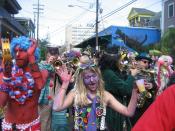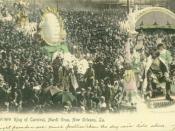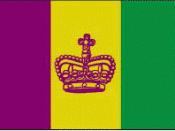MARDI GRAS: THE WORLD'S BIGGEST FREE PARTY! TABLE OF CONTENTS Intro History of Mardi Gras Krewes Balls First-timers The History of King Cake Glossary Bibliography Conclusion ABSTRACT This paper is about Mardi Gras, the world's biggest free party. Throughout the paper, you will see how Mardi Gras began and its traditions. Mardi Gras has become a traditional holiday in the city of New Orleans for people from all around the world. Experience the atmosphere of the holiday, and pretend you are there.
History of Mardi Gras Mardi Gras was first celebrated in the Christian countries of Europe. In 1699, French-Canadian explorer Sieur d'Iberville and his men camped out 60 miles south of New Orleans. In that year on March 3, Mardi Gras was celebrated, and d'Iberville named that land Pointe du Mardi Gras. Historians say that Mardi Gras was celebrated with masked balls and street parties in New Orleans in the early 1700s.
By 1806, the festivities had gotten so out of hand, they were cancelled. The law was ignored. In 1817, masks were made illegal. In 1827 tableau balls or masked balls were so fashionable in the 1800s that the law limited them from January 1 to Mardi Gras day. This was done only to limit the celebration from lasting all year long. In 1837 the "season"ÃÂ lasted from November 1 to June 1.
There are two different stories about the start of the parades. Some say parades began in 1835, and others say they began in 1838. The first krewe to have a parade was the Mystic Krewe of Comus. A visit from Russian Grand Duke Alexis Romanoff was an inspiration to Rex, king of carnival. The grand duke fell in love with actress Lydia Thompson. Romanoff's favorite song became "If Ever I Cease to Love,"ÃÂ...


